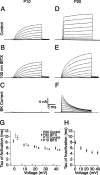Extrasynaptic localization of inactivating calcium-activated potassium channels in mouse inner hair cells
- PMID: 15509733
- PMCID: PMC6730162
- DOI: 10.1523/JNEUROSCI.3162-04.2004
Extrasynaptic localization of inactivating calcium-activated potassium channels in mouse inner hair cells
Abstract
Auditory hair cells from nonmammalian vertebrates are electrically tuned to specific sound frequencies primarily by the interactions of voltage-gated calcium channels and calcium-activated potassium (BK) channels colocalized at synaptic active zones. Mammalian inner hair cells are not electrically tuned and, yet, BK channels are also thought to reside at active zones. Using patch-clamp recordings and immunofluorescence, we characterized BK channel expression in mouse inner hair cells. Unexpectedly, these channels have inactivating currents and are clustered near the apex of the cell away from synaptic sites near the base. These results indicate a novel function of BK channels in mammalian inner hair cells and provide a framework for future research.
Figures




References
-
- Bekele-Arcuri Z, Matos MF, Manganas L, Strassle BW, Monaghan MM, Rhodes KJ, Trimmer JS (1996) Generation and characterization of subtype-specific monoclonal antibodies to K+ channel α- and β-subunit polypeptides. Neuropharmacology 35: 851-865. - PubMed
-
- Berglund AM, Ryugo DK (1991) Neurofilament antibodies and spiral ganglion neurons of the mammalian cochlea. J Comp Neurol 306: 393-408. - PubMed
-
- Fettiplace R, Fuchs PA (1999) Mechanisms of hair cell tuning. Annu Rev Physiol 61: 809-834. - PubMed
Publication types
MeSH terms
Substances
Grants and funding
LinkOut - more resources
Full Text Sources
Miscellaneous
